Introduction
Extraordinary Ministers of Holy Communion should receive sufficient spiritual, theological, and practical preparation to fulfill their role with knowledge and reverence. In all matters they should follow the guidance of the diocesan bishop.
Norms for the Distribution and Reception of Holy Communion Under Both Kinds for the Dioceses of the United States of America, no. 28
Your Responsibilities
Commissioning
1. It is the policy of the Archdiocese of Atlanta that all Extraordinary Ministers of Holy Communion (EMHCs) be trained in accordance with Archdiocesan guidelines.
2. All Ministers trained will be officially Commissioned & Certified by the Archdiocese for a period of three years.
3. After three years the Archdiocese requires a renewal program for those wishing to be re-certified.
4. Every EMHC requiring recertification will be notified by the Christ the King Liturgy Office. They will be expected to complete a brief update session of theology and procedures before being granted another three year certificate.
5. Christ the King’s training procedures meet and fulfill the Archdiocesan guidelines for proper certification. (It is also deemed acceptable that high-school age ministers, duly trained in authorized programs at their schools, are granted ministerial access to serve at Christ the King following familiarization of Cathedral practices and procedures by their Team Leaders.)
6. EMHCs who are verifiably certified by the Archdiocese at other parishes may serve at Christ the King only after receiving site-specific training in practices and procedures.
Scheduling
We use Ministry Scheduler Pro (MSP) to schedule all liturgical ministers. Once you have been trained for a particular ministry, you will sign yourself up to serve. While many people prefer to serve at the same mass time, you may sign up to serve at any weekend mass.
We ask that if you sign up, but then cannot serve, you simply cancel your sign up or post a sub request if it’s Friday or later for the current weekend.
If you arrive at a mass where you are not scheduled to serve, but are available to do so. Please check with the mass leader to see if you are needed and sign in on the iPad in the outer sacristy and also on the assignment location page for that mass.
Liturgical Objects
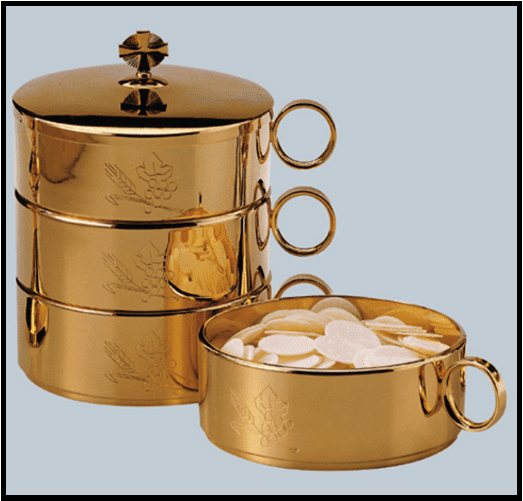
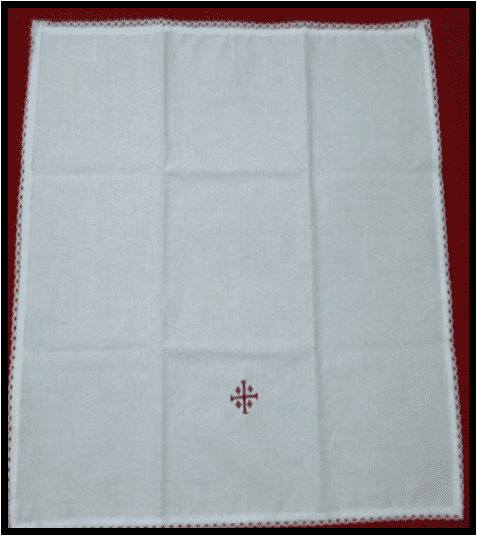
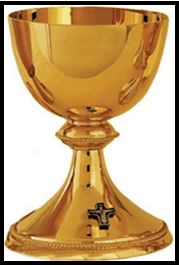
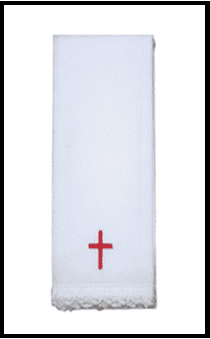
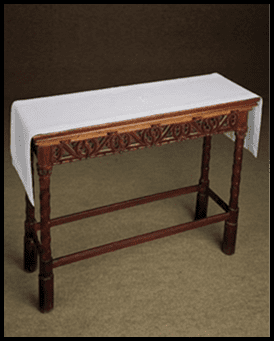
Who You Are
1. All EMHCs should show the greatest reverence for the Most Holy Eucharist by their demeanor, their attire, and the manner in which they handle the consecrated bread or wine.
2. Be in a state of grace; fast before Mass and have made a recent confession.
3. Refrain from using strong cologne, perfume or aftershave because:
- Some people have sensitivities to these scents.
- Fragrances often remain on your hands and can be transferred to the Eucharist.
Proper Dress
EMHCs should show the greatest reverence for the Most Holy Sacrament by their demeanor and their attire. They should dress in a way that is dignified and shows respect for the liturgy where they are serving, and the function they are carrying out. Any clothing that distracts from the solemnity of the liturgy should not be worn, nor should any clothing bearing prominent logos or slogans. Clothing that is “revealing” should be avoided in all circumstances.
Preferred dress for men includes a coat/tie, dress shirt, dress pants, and dress shoes. Preferred dress for women includes suitable-length dresses, skirts (at knee or just above), pants, or comparable attire; avoiding strapless/halter dresses or shirts. For everyone, no shorts, torn garments, or flip-flops at any time; and no jeans or athletic shoes on Sundays.
Every liturgy has a “personality”. You will observe what is acceptable at the liturgy where you serve regularly. Please err on the side of conservatism or check with the mass leader if you are unsure about acceptable dress.
The Lord’s Day
Before Mass
1. Arrive at least twenty minutes prior to the beginning of the Liturgy so your Team Leader can determine coverage for mass or masses.
2. Check in for your assignment in the Outer Sacristy.
3. While in the Sacristy area, please keep conversations to a minimum. We want to provide the Priest an atmosphere where he can quietly prepare himself for the sacrifice of the Mass.
Seating
1. The 1st pews on either side of the church are reserved for ministers. Lectors to the left and EMHCs to the right.
2. Always exit through the door of the outer sacristy by the Marian altar/Peachtree Street side.
3. Once seated, use this time to prepare yourself spiritually with prayer and meditation.
Ask God to assist you by His grace to be an effective and eager minister at the Eucharist.
Pray for the clergy and people with whom you will be communicating the Eucharist.
4. Be present in your role as a Liturgy Minister. Lead by example; Catch up with your fellow EMHCs after Mass.
From the Pew to the Altar
1. At the Sign of Peace, move toward the Marian altar(Peachtree Street), outer sacristy door. Reverence the altar either in the center aisle as you cross or outside the altar rail near the Marian altar.
2. Gather and participate in the sign of peace quietly in the outer sacristy.
3. Wash your hands with the disinfectant provided.
4. When the Priest receives from the chalice, proceed to the altar – no need to bow again.
Remember: Whenever you are holding Christ in the form of His Body or Blood, you do not need to reverence the Altar.
Positioning of EMHCs in the Nave
The EMHCs form three sides of a rectangle behind the Altar. The sides of the rectangle run from the rear candles on either side of the Altar to the steps of the Tabernacle. The back side of the rectangle runs parallel to the back side of the altar just in front of the Tabernacle steps.
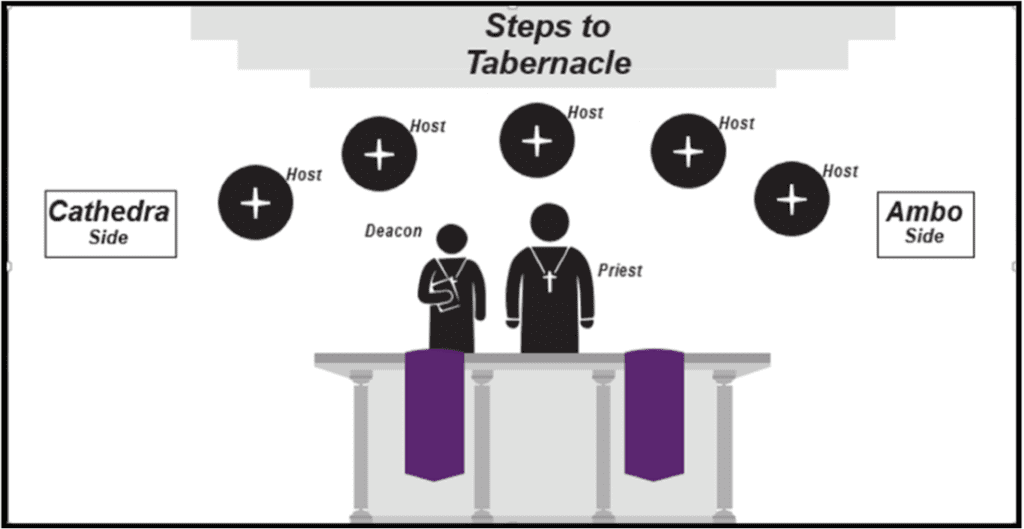
Communicating EMHCs
1. The Priest or Deacon will communicate the Precious Body to the EMHCs starting from the east side (Ambo) candle. If present, the Deacon will follow him with the Precious Blood.
2. The Priest will then communicate the Ministers of the Cup with the Precious Blood, leaving their cup with them while the Deacon completes communicating the Precious Blood to the Ministers of the Body. If no Deacon is present, the priest may ask the Ministers of the Cup to communicate the other ministers.
3. EMHCs should not communicate each other unless directed by the Priest.
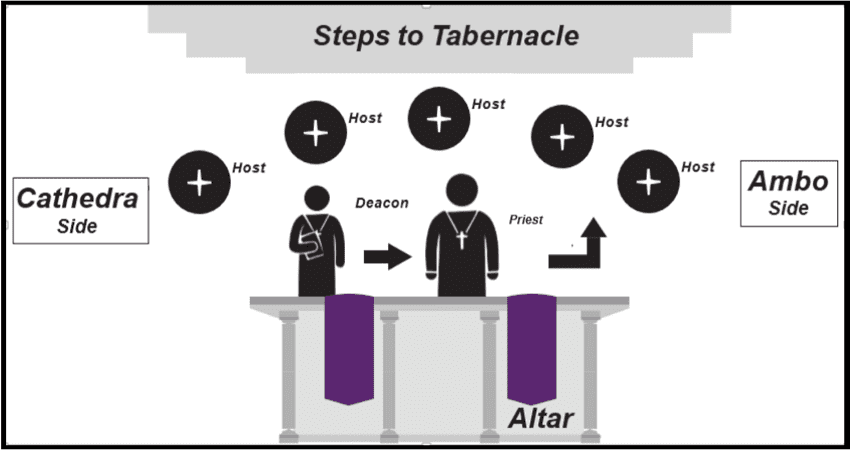
Distributing the Ciboria
1. The Deacon will then hand the ciboria to the Ministers of the Body.
2. Do not take vessels from the altar unless the Priest or Deacon have left the altar.
3. Go immediately to your stations, if you have a clear path to do so – do not pause and wait for other EMHCs to receive their vessels, or for the Priest to leave the altar.
4. Ministers of the Cup from the front stations should communicate the Altar servers after the Priest has communicated the Precious Body, and then go to their stations.
Note: Be flexible – not all Clergy celebrate in the same way!
Positioning of EMHCs in Nave From the Altar to Your Station
Option #1 | Six Ciboria and Six Chalices
(Maximum number of EMHCs for larger Masses)
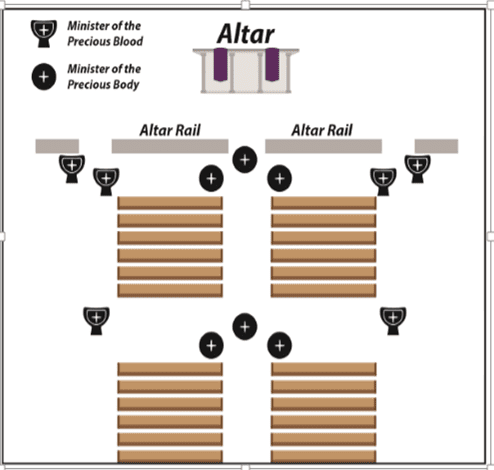
At the Front Stations:
- The Priest is in the center (as close to the step as possible, if not on it).
- One Deacon and one EMHC or two EMHCs (if no Deacon) are located along the front of each of the first pews facing each other. They should touch the pews with their knee if nobody is in the way.
- This set-up should allow enough space for three lines of communicants to process down the aisle and to pass on either side of the Priest after receiving.
- The EMHCs of the Precious Blood (one or two on each side) should be as far to the sides as possible – preferably just at and /or beyond the side sanctuary gates to prevent bottlenecks from occurring.
At the Middle Stations:
- The same formation will apply at the Middle Stations.
Note: The maximum number of EMHCs for communicating the Body of Christ should be six EMHCs – three in the front of the church and three in the middle of the church.
Option #2 | Four Ciboria and Four Chalices
Fewer number of EMHCs for smaller Masses
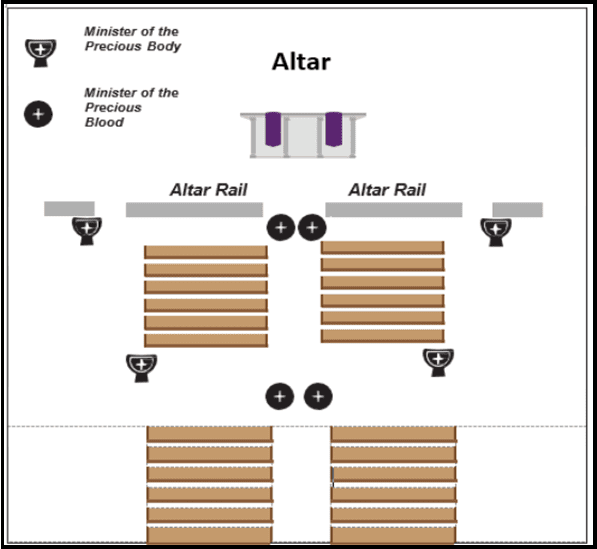
At the Front Stations:
- A Priest and Deacon or a Priest and EMHC split the center of the aisle.
At the Middle Stations:
- The same formation will apply in the middle of the Church. The stations of the Priest and the Deacon in the front will be assumed by EMHCs in the middle.
If there are five stations, a Priest and Deacon or a Priest and two EMHCs can be stationed at the front or the middle depending on which is more crowded.
Communicating Altar Servers
The Priest and Deacon will communicate the Precious Body to Altar Servers before working their way to their stations. If they do not, please do so. The Precious Blood will be communicated by EMHCs assigned to the front stations.
Communicating the first rows (in the front & rear sections)
The EMHCs/Body communicate the entire front row (in both front & rear sections) with the parishioners IN PLACE. Work your way from the outside to the center where you stand. The Ministers of the Precious Blood should remain in place and allow these congregants to come to them.
The Blessing
Those approaching the EMHC with arms folded across the chest should receive a blessing.
Do
- Use the words “May God bless you and keep you” with hand raised from the elbow upward.
Don’t
- Do not say the name of the person, even if you know them.
- Do not distribute the Body or Blood to anyone with folded arms across their chest.
- Do not hold the Precious Body while giving the blessing.
- Do not make the sign of the cross (for Clergy only).
- Do not touch the communicant! Touching anything besides the hosts has the potential to contaminate your hands.
Communicating the Precious Body
Q: How do I hold the Precious Body?
A: The EMHC holds the Precious Body slightly above the ciborium between their finger and their thumb. If your finger is on the top of the Precious Body and your thumb on the bottom, it will be easier to communicate on the tongue.
Q: What should I do?
A: Make good eye contact with each communicant and smile!
You are representing Christ. Respect the option of the communicant to receive either in the palm of the hand or on the tongue.
Q: What should I say?
A: Look at the communicant and says in a clear voice: “The Body of Christ!” Do not add any other words. Wait for the communicant to say, “Amen.” Reverently place the Precious Body in the communicant’s hands. If at all possible, observe the person consuming the Precious Body.
If you drop the Precious Body:
Immediately pick up the Precious Body. Then you may either:
- consume the Precious Body immediately, or
- hold it in the same hand as the ciborium to be dealt with after Communion, or
- return it to the Altar, and isolate it on the corporal to be dealt with after Communion.
If the Precious Body has been isolated and not previously consumed, the EMHC returns to the altar after distribution, and either consumes it then, or brings it to the Sacristy where it may be completely dissolved in a bowl of water, which is then poured into the special sink (sacrarium). The Precious Body that is dropped is never to be replaced in the ciborium or given to the next communicant.
Communicating the Precious Blood
Q: How do I hold the purificator?
A: Open the purification. Then:
- Drape it over your index (or index and middle finger), so that it covers the palm of your hand.
- Let it hang free or put the hanging end between your ring finger and pinky finger. This allows you to control the purificator and have a groove between your index and middle finger to place on the lip of the chalice as you wipe it after a person has received.
- Make sure to wipe both outside and inside the rim!
- Adjust the purificator several times during Communion so that more than one single area of the purificator is utilized for wiping.
- Wipe the lip of the chalice gently (remember you are not polishing it!)
- Do a visual check from time to time to make sure there are no marks on the chalice lip.
- Turn the chalice after someone receives, so that each person drinks from a spot on the rim next to the last rather than from the same spot.
Q: What should I do?
A: Again, make good eye contact with each communicant and smile! You are representing Christ. In administering the chalice, hold it up slightly to the communicant. Reverently place the chalice in the communicant’s hands; they will drink from it and return it to you. Then wipe the rim of the cup with the purificator, give the cup a quarter turn, and offer it to the next communicant.
Q: What should I say?
A: Say in a clear voice while looking at the communicant: “The Blood of Christ!” Do not add any other words. Wait for the communicant to say, “Amen.”
If the Precious Blood spills:
The EMHC should cover the spillage with a purificator. Clean up the space as best you can with the purificator. If the spill is still too large to properly clean place a purificator over the spot and go to the sacristy to get more purificators or towels. Leave your chalice on the credence table while you clean up the spill.
After Mass, the area should be washed with a damp clean purificator. Clean (damp) towels should be used if the area is larger. The cloths used for cleaning are rinsed and then wrung into the sacrarium.
From Your Station to the Altar and Back to Your Pew
If you are the EMHC for the Precious Body:
- Bring the remaining Precious Body to the Priest or Deacon who will consolidate or take the entire ciborium to the tabernacle.
- Once you hand the ciborium to the Priest, do not wait – exit to the outer sacristy and return to your pew via the side door that you entered. (The Altar Servers are responsible for taking the empty ciborium back to the credence table.)
- Return to your seat by exiting to the outer sacristy exit via the Marian Altar side door from which you entered. Bow at center aisle before sitting or kneeling. (Remember: when you are holding Jesus, you do not need to bow. At all other times, you should bow when you cross the altar.)
If you are the EMHC for the Precious Blood:
1. EMHCs of the Precious Blood should proceed across the altar to the Outer Sacristy where they consume any remaining Precious Blood.
2. Place the empty chalice on the credence table to be purified. (Do not put the purificator into the chalice.)
3. The Deacon or Priest will finish the purification.
4. Once you place the chalice on the credence table, DO NOT LINGER! Exit to the Outer Sacristy and return to your pew via the Marian Door.
If you are not comfortable finishing the Precious Blood in your chalice, ask the other ministers to help or leave it with the Precious Blood that remains on the credence table.
After Mass
1. Help out your Team Leader cleansing the vessels after Mass. Cleansing the vessels takes less than 10 minutes and many hands make light work.
2. Vessels should have been purified after Communion. If not, find a Priest or Deacon to do so.
3. Wash all chalices with soap and water in the left sink (not the sacrarium). Dry chalices & ciboria with towels from the drawers. The ciboria do not have to be washed—just thoroughly dried.
4. If this is the last Mass of the day, put all vessels into the safe. If another Mass follows, place the clean vessels near the sink so the next Team Leader can set up for Mass.
5. Place all used altar linens and towels in the appropriate bag in the closet.
FAQs—The Precious Body
Q: What if someone’s holding a baby and trying to take the Precious Body by hand?
A: First, give the child a blessing. Then, communicate the Precious Body on the tongue. (If you say “The Body of Christ” and raise it to their lips, they will take it.)
Q: What if a person doesn’t hold up their hands, stick out their tongue or cross their arms?
A: Give them a blessing. You don’t need to ask; just use your best judgment. They will correct you if they want to receive.
Q: What if someone has celiac disease and needs the Precious Body in a low gluten form?
A: The Priest will know that beforehand and will assure one is available and will distribute it themselves or designate someone to distribute.
Q: What if I run out of the Precious Body?
A: Look to the other EMHCs. When you run out: if there are few communicants in line, let other EMHCs communicate and go to the altar. If there are many communicants and other EMHCs have the Precious Body in their ciboria, ask to take some and finish communicating. If everyone has run out, give blessings. Do not break in half unless instructed by a Priest.
FAQs—The Precious Body
Q: What if someone who’s visibly shaking wants the Precious Blood?
A: In most cases, you will hand the chalice to the communicant. If you feel there may be a possibility of a spill, hold the chalice while they consume. Use your best judgement.
Q: What if I’m communicating the Precious Blood and someone comes to me with their arms crossed?
A: Give them a blessing. There’s never too many blessings in life!
Q: What if someone tries to dip the Precious Body into the Precious Blood?
A: Place the purificator over the chalice and ask them to consume first. While this process, known as intinction is deemed permissible by The Archdiocese of Atlanta, SELF-INTINCTION is not. Only clergy may communicate the Eucharist to the Faithful in this way and at their discretion. It is not a regular practice at the Cathedral.
Denying Holy Communion
There are practically no situations when Holy Communion should be denied by an EMHC to a Catholic. Church norms state that: “Any baptized Catholic who is not prevented by law must be admitted to Holy Communion” (Redemption is Sacramentum 91). The EMHC should not make a judgment on the worthiness of any individual to receive Holy Communion. In the case of individuals clearly living a life in discrepancy with church teachings, the decision is to be made by the Priest, in consultation with the Archbishop, and he will then inform the EMHC involved.